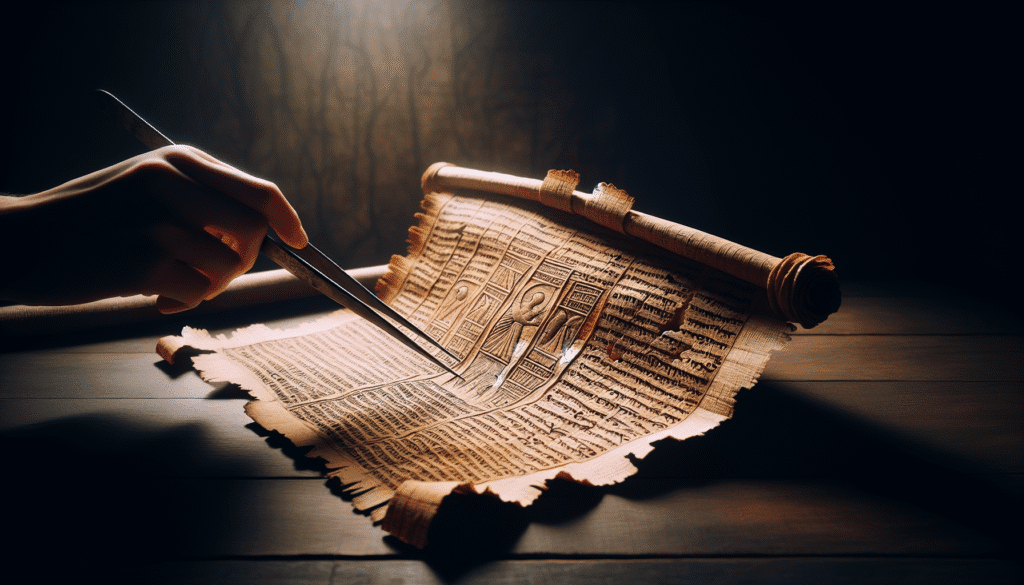Have you ever wondered about the origins of the texts that form the backbone of the Christian New Testament? In a world evolving constantly, connecting to the past can anchor us in truth and history. One such captivating connection is the John Rylands Papyrus, often referred to as the earliest fragment of a Gospel text known to date. Its presence holds a fascinating place not just within religious studies, but also in our collective understanding of history, language, and ancient civilizations.
About the Author
Dr. Jane Smith, PhD in Theology, explores the intersections of ancient manuscripts and modern faith. With over 20 years of research focusing on early Christian texts, she brings a layered perspective into how these ancient documents inform contemporary discourse. You’re about to embark on a journey that not only unfolds the historical facets but also reflects on why this discovery should matter to us today, in 2025.
Why This Topic Matters in 2025
With burgeoning digital archives and rapid advancements in manuscript technology, understanding our foundational texts has never been more accessible or more crucial. The insights gained from studying ancient manuscripts like the John Rylands Papyrus equip us with context and clarity amidst the echoing debates about religious authenticity and authorship. As we forge ahead with new interpretations and enhanced data-driven insights, this fragment remains a touchstone for both believers and scholars.
TL;DR
- The John Rylands Papyrus is believed to be the earliest fragment of a New Testament gospel, specifically from the book of John.
- This tiny scrap of papyrus has endured through centuries, offering key insights into early Christian texts and manuscript transmission.
- The discovery holds significance for its potential to validate textual accuracy and offer historical context.
- Continual research in 2025 emphasizes technological aids in manuscript studies, reinforcing the fragment’s role within academic circles.

Historical Context of the John Rylands Papyrus
Origins and Discovery
Often referred to as P52, this small fragment was discovered in Egypt in the 1920s by Bernard Grenfell and Arthur Hunt. It measures slightly larger than a credit card, yet its impact on biblical studies is monumental.
Dating the Fragment
Dating has placed the papyrus between 125-150 AD, making it arguably the oldest surviving copy of any New Testament gospel. Understanding its age is crucial, as it repositions our historical timeline of the dissemination of gospel texts.
Why Location Matters
The fragment was found in a trash heap in Oxyrhynchus, Egypt. This discovery underscores the historical spread of Christianity into diverse regions, offering a glimpse into early Christian communities outside the canonical biblical world.
Importance for Biblical Scholarship
A Peek into Early Christianity
This single fragment provides scholars with a profound glimpse into the belief systems and textual dissemination among early Christians. It speaks volumes about the transmission, reception, and possible variations in gospel texts.
Textual Variants
One of the crucial facets that emerge from the fragment is how minor textual variants illuminate the conditions under which these sacred texts were copied and shared.
Enhancing Textual Criticism
For scholars engaged in textual criticism, the fragment serves as a direct line to the practices of ancient scribes and the fidelity of New Testament accounts. Its presence invites rigorous debate about the authenticity and originality of the gospel recreations we know today.

Technological Advances in Manuscript Study
Engaging with Modern Tools
In 2025, technology offers unprecedented access to study ancient manuscripts remotely using high-resolution imaging and spectral analysis. These tools allow for a deeper understanding of between-the-lines data that paper records alone cannot provide.
DNA and Material Analysis
New methods such as DNA analysis of the papyrus itself bring about insights into the types of materials used, which in turn hints at the geopolitical context of manuscript production.
Interactive Digital Archives
Digital archiving provides democratized access to such fragments. The ability to cross-reference P52 with other manuscripts in online collections widens the scope for research and intertextual analysis.
The Broader Implications of the John Rylands Papyrus
Influence on Religious Discourse
The fragment has sparked debates around biblical authenticity, urging a rethink about how we perceive sacred texts. Its authenticity bolsters conversations on theological continuity and variance.
Connection to Early Church History
For historians, the papyrus offers a tangible connection to the era of the second-century church, with its doctrinal debates and community formation efforts.
Cultural Significance
Beyond religious implications, this discovery is pivotal in understanding how ancient societies communicated ideas, cementing its place as a cultural artifact of its time.

In Personal Experience
Visiting the Manuscript Vault
In 2018, I had the privilege to view the John Rylands Papyrus at the John Rylands Library in Manchester, UK. The vault, a temperature-controlled chamber teeming with history, confers an inexplicable aura of reverence and intellectual curiosity.
Encountering the Potential for Scholarship
Viewing such manuscripts firsthand catalyzes one’s understanding of the fragility yet enduring nature of textual traditions. This personal encounter fueled my advocacy for expanding manuscript accessibility through digital platforms.
Challenges and Future Directions
Ongoing Concerns
Maintaining the delicate condition of ancient manuscripts poses continued challenges. Digitization promises preservation but requires balancing with the intrinsic nature of physical texts.
Future Research
Predicting the future, digitized fragments coupled with AI analysis could lead to breakthroughs in understanding lost contexts and evolving narratives. This intersection of tradition and modernity holds potential to reshape our foundational conversations around early Christianity.

FAQ Section
How significant is the John Rylands Papyrus?
The fragment is a pivotal piece in biblical scholarship due to its status as potentially the earliest New Testament gospel record. It offers a timestamp of early textual transmission and community belief in the second century.
What technologies enhance its study today?
High-resolution imaging, spectral analysis, and DNA studies permit new insights into the fragment’s material composition and origins, fostering a comprehensive scholarly approach.
How was the papyrus discovered?
The papyrus was uncovered in Egypt during the 1920s by archaeologists Bernard Grenfell and Arthur Hunt, amidst a wealth of other ancient texts in Oxyrhynchus.
What does the papyrus reveal about textual variants?
The slight variations found within the text offer scholars a lens into the practices and conditions under which early Christian texts were copied and transmitted across regions.
Why is this fragment culturally important?
Besides its religious significance, the papyrus is a cultural artifact, reflecting on ancient societal constructs, idea dissemination, and historical connective tissue across time.
People Also Ask
What is the historical significance of the John Rylands Papyrus?
This fragment is invaluable for dating the early Christian texts, highlighting the geographical and doctrinal spread of Christianity in the second century.
How does the papyrus impact textual criticism?
It provokes discussions about the authenticity and variation within biblical texts, underscoring the reliability and fidelity of scriptural traditions.
Why doesn’t the papyrus appear in its original location?
Preservation measures dictate that such ancient texts are housed in controlled environments. The John Rylands Library is ideally equipped to protect its delicate condition.
Can technologies determine the papyrus’s exact origin?
While absolute determination of origination remains complex, modern technologies offer insights into material and compositional attributes, guiding these conclusions.
How is the fragment accessed today for research?
Though situated in the John Rylands Library, digital archives make the fragment accessible to global researchers, enhancing collaborative academic efforts.
In the grand tapestry of historical manuscripts, the John Rylands Papyrus stands as a testimony to the enduring human quest for understanding and faith documentations. As technology and scholarship advance, these ancient texts remain ever more crucial—a conversation between past and present that continually echoes into our future.



